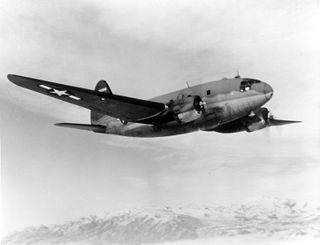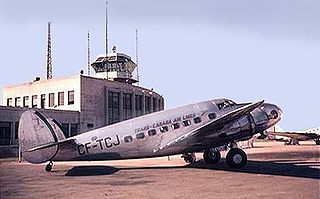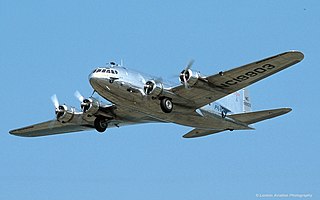
The Consolidated B-24 Liberator is an American heavy bomber, designed by Consolidated Aircraft of San Diego, California. It was known within the company as the Model 32, and some initial production aircraft were laid down as export models designated as various LB-30s, in the Land Bomber design category.

The Douglas C-47 Skytrain or Dakota is a military transport aircraft developed from the civilian Douglas DC-3 airliner. It was used extensively by the Allies during World War II and remained in front-line service with various military operators for many years.

The Curtiss C-46 Commando is a twin-engine transport aircraft derived from the Curtiss CW-20 pressurised high-altitude airliner design. Early press reports used the name "Condor III" but the Commando name was in use by early 1942 in company publicity. It was used as a military transport during World War II by the United States Army Air Forces and also the U.S. Navy/Marine Corps, which called it R5C. The C-46 served in a similar role to its Douglas-built counterpart, the C-47 Skytrain, but it was not as extensively produced as the latter.

The Avro 691 Lancastrian was a Canadian and British passenger and mail transport aircraft of the 1940s and 1950s developed from the Avro Lancaster heavy bomber. The Lancaster was named after Lancaster, Lancashire.

The Hump was the name given by Allied pilots in the Second World War to the eastern end of the Himalayan Mountains over which they flew military transport aircraft from India to China to resupply the Chinese war effort of Chiang Kai-shek and the units of the United States Army Air Forces (USAAF) based in China. Creating an airlift presented the USAAF a considerable challenge in 1942: it had no units trained or equipped for moving cargo, and no airfields existed in the China Burma India Theater (CBI) for basing the large number of transports that would be needed. Flying over the Himalayas was extremely dangerous and made more difficult by a lack of reliable charts, an absence of radio navigation aids, and a dearth of information about the weather.
Aphrodite was the World War II code name of a United States Army Air Forces operation to use Boeing B-17 Flying Fortress and Consolidated PB4Y bombers as precision-guided munitions against bunkers and other hardened/reinforced enemy facilities. A parallel project in the United States Navy was codenamed Anvil. The missions were not generally successful, and the intended targets in Europe were either overrun by the ground advance of Allied troops or disabled by conventional attacks by aircraft.

The Boeing C-108 Flying Fortress was an American transport aircraft used during World War II. Four were converted from B-17 Flying Fortress heavy bombers.

The Lockheed Model 14 Super Electra was an American civil passenger and cargo aircraft built by the Lockheed Aircraft Corporation during the late 1930s. An outgrowth of the earlier Model 10 Electra, the Model 14 was also developed into larger, more capable civil and military versions.

The Boeing Model 307 Stratoliner is an American stressed-skin four-engine low-wing tailwheel monoplane airliner derived from the B-17 Flying Fortress bomber, which entered commercial service in July 1940. It was the first airliner in revenue service with a pressurized cabin, which with supercharged engines, allowed it to cruise above the weather. As such it represented a major advance over contemporaries, with a cruising speed of 220 mph (350 km/h) at 20,000 ft (6,100 m) compared to the Douglas DC-3s 160 mph (260 km/h), at 8,000 ft (2,400 m) then in service. When it entered commercial service it had a crew of five to six, including two pilots, a flight engineer, two flight attendants and an optional navigator, and had a capacity for 33 passengers, which later modifications increased, first to 38, and eventually to 60.

The Beechcraft Model 18 is a 6- to 11-seat, twin-engined, low-wing, tailwheel light aircraft manufactured by the Beech Aircraft Corporation of Wichita, Kansas. Continuously produced from 1937 to November 1969, over 9,000 were built, making it one of the world's most widely used light aircraft. Sold worldwide as a civilian executive, utility, cargo aircraft, and passenger airliner on tailwheels, nosewheels, skis, or floats, it was also used as a military aircraft.

The Consolidated PB4Y-2 Privateer is an American World War II and Korean War era patrol bomber of the United States Navy derived from the Consolidated B-24 Liberator. The Navy had been using B-24s with only minor modifications as the PB4Y-1 Liberator, and along with maritime patrol Liberators used by RAF Coastal Command this type of patrol plane was proven successful. A fully navalised design was desired, and Consolidated developed a dedicated long-range patrol bomber in 1943, designated PB4Y-2 Privateer. In 1951, the type was redesignated P4Y-2 Privateer. A further designation change occurred in September 1962, when the remaining Navy Privateers were redesignated QP-4B.

The Consolidated R2Y "Liberator Liner" was an airliner derivative of the B-24 Liberator built for the United States Navy by Consolidated Aircraft.

Consolidated Liberator I was the service name of the first Consolidated B-24 Liberator four-engined bombers to see use with the Royal Air Force (RAF).

The Douglas XCG-17 was an American assault glider, developed by the conversion of a C-47 Skytrain twin-engine transport during World War II. Although the XCG-17 was successfully tested, the requirement for such a large glider had passed, and no further examples of the type were built; one additional C-47, however, was converted in the field to glider configuration briefly during 1946 for evaluation, but was quickly reconverted to powered configuration.

The 1943 Liberator crash at Whenuapai was an aircraft accident in New Zealand during World War II.

The Chase XC-123A was an experimental transport aircraft developed by Chase Aircraft. The first jet-powered transport built for the United States Air Force, it was intended for use as a high-speed transport for high-priority cargo and personnel. The XC-123A was determined to have insufficient advantages over existing types in service, and did not go into production. The sole prototype was converted into the piston-powered Stroukoff YC-123D to evaluate boundary layer control systems.

The Lockheed C-69 Constellation was a four-engined, propeller-driven military transport aircraft developed during World War Two. It was co-developed with the Lockheed Constellation airliner.

The Douglas DC-2 is a 14-passenger, twin-engined airliner that was produced by the American company Douglas Aircraft Company starting in 1934. It competed with the Boeing 247. In 1935, Douglas produced a larger version called the DC-3, which became one of the most successful aircraft in history.
This is a partial list of notable accidents and incidents involving the Consolidated-designed B-24 Liberator. Combat losses are not included except for some cases denoted by singular circumstances. Consolidated C-87 Liberator Express and PB4Y Privateers are also included.



















